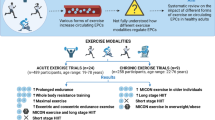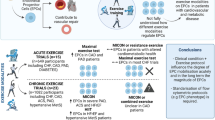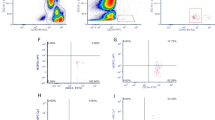Abstract
Exercise is known to improve endothelial function in healthy subjects as well as patients with cardiovascular disease and this might be partially related to a regeneration of diseased endothelium by circulating progenitor cells (EPCs). EPCs are a subgroup of peripheral blood monocytes that contribute to re-endothelialization of injured endothelium as well as neovascularization of ischemic lesions. Cross-sectional studies have indicated that chronic, regular physical activity has a positive effect on the levels of circulating EPCs. This is associated with an improvement of endothelial dysfunction that is induced by apoptosis due to the underlying aging process or accelerated by cardiovascular risk factors. Furthermore, it is well established that chronic exercise training has the potency to mobilize EPCs from the bone marrow. For patients with cardiac disease this is of clinical importance since EPCs have been implicated in vascular repair and revascularization. Studies are needed to refine the best mode of exercise training that will upregulate circulating EPCs as well as to clarify the kinetics of EPCs after the termination of different exercise sessions in different diseases and medication. Whether there is a direct link between enhanced mobilization of EPCs via exercise and improvement of disease and prognosis remains a hypothesis which needs to be further evaluated.


Similar content being viewed by others
References
Hambrecht R, Wolf A, Gielen S, Linke A, Hofer J, Erbs S, Schoene N, Schuler G (2000) Effect of exercise on coronary endothelial function in patients with coronary artery disease. N Engl J Med 342:454–460
Goto C, Higashi Y, Kimura M, Noma K, Hara K, Nakagawa K, Kawamura M, Chayama K, Yoshizumi M, Nara I (2003) Effect of different intensities of exercise on endothelium-dependent vasodilation in humans. Role of endothelium-dependent nitric oxide and oxidative stress. Circulation 108:530–535
Pynn M, Schafer K, Konstantinidis S, Halle M (2004) Exercise training reduces neointimal growth and stabilizes vascular lesions developing after injury in apolipoprotein e-deficient mice. Circulation 109(3):386–392
Fernandes L, Serrano CV, Toledo F, Hunziker MF, Zamperini A, Teo FH, Oliveira RT, Blotta MH, Rondon MU, Negrao CE (2011) Acute and chronic effects of exercise on inflammatory markers and B-type natriuretic peptide in patients with coronary artery disease. Clin Res Cardiol 100(1):77–84
Schaechinger V, Britten MB, Zeiher AM (2000) Prognostic impact of coronary vasodilator dysfunction on adverse long-term outcome of coronary heart disease. Circulation 101(16):1899–1906
Asahara T, Murohara T, Sullivan A, Silver M, van der Zee R, Li T, Witzenbichter B, Schattteman G, Isner JM (1997) Isolation of putative progenitor endothelial cells for angiogenesis. Science 275:964–967
Dimmeler S, Aicher A, Vasa M, Mildner-Rihm C, Adler K, Tiermann M, Ruetten H, Fichtlscherer S, Martin H, Zeiher A (2001) HMG-CoA reductase inhibitors (statins) increase endothelial progenitor cells via the PI 3- kinase/Akt pathway. J Clin Invest 108:391–397
Aicher A, Zeiher A, Dimmeler S (2005) Mobilizing endothelial progenitor cells. Hypertension 45(321–32):5
Jung Jung C, Fischer N, Fritzenwanger M, Thude H, Ferrari M, Fabris M, Brehm BR, Barz D, Figulla HR (2009) Endothelial progenitor cells in adolescents: impact of overweight, age, smoking, sport and cytokines in younger age. Clin Res Cardiol 98(3):179–188
Urbich C, Dimmeler S (2004) Endothelial progenitor cells: characterization and role in vascular biology. Circ Res 95:343–353
Hirschii KK, Ingram D, Yoder MC (2008) Assessing identity, phenotype, and fate of endothelial progenitor cells. Arterioscler Thromb Vasc Biol 28:1584–1595
Hur J, Yoon CH, Kim HS, Cho JH, Kang HJ, Hwang KK, Oh BH, Lee MM, Park YB (2004) Characterization of two types of endothelial progenitor cells and their different contribution to neovasculogenesis. Arterioscler Thromb Vasc Biol 24:288–293
Hill JM, Zalos G, Halcox JPJ, Schenke WH, Waclawiw MA, Quyyumi AA, Finkel T (2003) Circulating endothelial progenitor cells, vascular function and cardiovascular risk. N Engl J Med 348:593–600
Werner N, Kosiol S, Schiegl T, Ahlers P, Walenta K, Link A, Bohm M, Nickenig G (2005) Circulating endothelial progenitor cells and cardiovascular outcomes. N Engl J Med 353(10):999–1007
George J, Goldstein E, Abashidze S et al (2004) Circulating endothelial progenitor cells in patients with unstable angina: association with systemic inflammation. Eur Heart J 25:1003–1008
Massa M, Rosti V, Ferrario M et al (2005) Increased circulating hematopoietic and endothelial progenitor cells in the early phase of acute myocardial infarction. Blood 105:199–206
Perin EC, Dohmann HFR, Borojevic R, Silva SA, Sousa ALS, Silva GV, Mesquita CT, Belem L, Vaughin WK, Rangel FOD, Assad JAR, Carvalho AC, Branco RVC, Rossi MID, Dohmann HJF, Willerson JT (2004) Improved exercise capacity and ischemia 6 and 12 months after transendocardial injection of autologous bone marrow mononuclear cells for ischemic cardiomyopathy. Circulation 110(SII):213–218
Schaehinger V, Erbs S, Elsaesser A, Haberbosch W, Hambrecht R, Hoelschermann H, Yu J, Corti R, Mathey DG, Hamm CW, Sueselbeck T, Assmus B, Tonn T, Dimmmeler S, Zeiher AM (2006) Intracoronary bone marrow-derived progenitor cells in acute myocardial infarction. N Engl J Med 355(12):1210–1221
Bonsignore MR, Morici G, Santoro A, Pagano M, Cascio L, Bonano A, Insalaco G, Abate P, Mirabella F, Profita M, Gioia M, Vignola AM, Majolino I, Testa U, Hogg JC (2002) Circulating hematopoietic cells (HPCs) in well-trained runners. J Appl Physiol 93:1697–2002
Hoetzer G, Van Guilder GP, Irmiger H, Keith S, Stauffer B, DeSouza C (2007) Aging, exercise, and endothelial progenitor cell clonogenic and migratory capacity in men. J Appl Physiol 102:847–852
Luk TH, Dai YL, Siu CW, Yiu KH, Chan HT, Fong DY, Lee SW, Li SW, Tam S, Lau CP, Tse HF (2009) Habitual physical activity is associated with endothelial function and endothelial progenitor cells in patients with stable coronary artery disease. Eur J Cardiovasc Prev Rehabil 16(4):464–471
Yang Z, Xia WH, Su C, Wu F, Zhang YY, Xu SY, Liu X, Zhang XY, Ou ZJ, Lai GH, Liao XX, Jin YF, Tao J (2011) Regular exercise-induced increased number and activity of circulating endothelial progenitor cells attenuates age-related decline in arterial elasticity in healthy men. Int J Cardiol (in press)
Manfredini F, Rigolin GM, Malagoni AM, Soffritti S, Boari B, Conconi F, Castoldi GL, Catizone L, Zamboni P, Manfredini R (2007) Exercise capacity and circulating endothelial progenitor cells in hemodialysis patients. Int J Sports Med 28:368–373
Rehmann J, Li J, Parvathaneni L, Karlsson G, Panchal VR, Temm CJ, Mahenthiran J, March KL (2004) Exercise acutely increases circulating endothelial progenitor cells and monocyte-/macrophage derived angiogenic cells. J Am Coll Cardiol 43:2314–2318
Adams V, Lenk J, Linke A, Lenz D, Erbs S, Sandri M, Tarnok A, Gielen S, Emmrich F, Schuler G, Hambrecht R (2004) Increase of circulating endothelial progenitor cells in patients with coronary artery disease after exercise-induced ischemia. Arterioscler Thromb Vasc Biol 24:684–690
Sandri M, Beck EB, Adams V, Gielen S, Lenk K, Höllriegel R, Mangner N, Linke A, Erbs S, Moebbious-Winkler S, Scheinert D, Hambrecht S, Schuler G (2011) Maximal exercise, limb ischemia, and endothelial progenitor cells. Eur J Cardiovasc Prev Rehabil 18(1):55–64
Laufs U, Urhausen A, Werner N, Scharhag J, Heitz A, Kissner G, Boehm M, Kindermann W, Nickenig G (2005) Running exercise of different duration and intensity: effect on endothelial progenitor cells in healthy subjects. Eur J Cardiovasc Prev Rehabil 12:407–412
Van Craenenbroeck EM, Beckers PJ, Possemiers NM, Wuyts K, Frederix G, Houmans VY, Wuyts F, Paelinck BP, Vrints CJ, Conraads VM (2010) Exercise acutely reverses dysfunction of circulating angiogenic cells in chronic heart failure. Eur Heart J 31:1924–1934
Yang Z, Wang JM, Chen L, Luo CF, Tang AL, Tao J (2007) Acute exercise-induced nitric oxide production contributes to upregulation of circulating endothelial progenitor cells in healthy subjects. J Human Hypertens 21:452–460
Thorell D, Borjesson M, Larsson P, Ulfhammer E, Karlsson L, DuttaRoy S (2009) Strenuous exercise increases late outgrowth endothelial cells in healthy subjects. Eur J Appl Physiol 107:481–488
Van Craenenbroeck EM, Vrints CJ, Haine SE, Vermeulen K, Goovaerts I, Van Tendeloo VF, Hoymans VY, Conraads VM (2008) A maximal exercise bout increases the number of circulating CD34+/KDR+ endothelial progenitor cells in healthy subjects: relation with lipid profile. J Appl Physiol 104(4):1006–1013
Thijssen D, Vos J, Verseyden C, Zonneveld A, Smits P, Sweep F, Hopman MTE, de Boer HT (2006) Haematopoietic stem cells and endothelial progenitor cells in healthy men: effect of aging and training. Aging Cell 5:495–503
Jenkins NT, Witkowski S, Spangenburg EE, Hagberg JM (2009) Effects of acute and chronic endurance exercise on intracellular nitric oxide in putative endothelial progenitor cells: role of NAPDH oxidase. Am J Physiol Heart Circ Physiol 297:H1798–H1805
Adams V, Linke A, Breuckmann F, Leineweber K, Erbs S, Kraenkel N, Βroecker-Preuss M, Woitek F, Erbel R, Heusch G, Hambrecht R, Schuler G, Moehlenkamp S (2008) Circulating progenitor cells decrease immediately after marathon race in advanced-age marathon runners. Eur J Cardiovasc Prev Rehabil 15(5):602–607
Goussetis E, Spiropoulos A, Tsironi M, Skenderi K, Margeli A, Graphakos S, Baltopoulos P, Papassotiriou I (2009) Spartathlon, a 246 kilometer foot race: effects of acute inflammation induced by prolonged exercise on circulating progenitor reparative cells. Blood Cells Molecules Dis 42:294–299
Moebius-Winkler S, Hilberg T, Menzel K, Golla E, Burman A, Schuler G, Adams V (2009) Time-dependent mobilization of circulating progenitor cells during strenuous exercise in healthy individuals. J Appl Physiol 107:1943–1950
Ciulla M, Giorgetti A, Lazzari L, Cortiana M, Silvestris I, Annoni G, De Asmundis C, Fiore AV, Mondelatici E, Paliotti R, Magrini F, Rebulla P, Cortelezzi A (2005) High-altitude trekking in the Himalayas increases the activity of circulating endothelial cells. Am J Hematol 79:76–78
Morici G, Zangla D, Santoro A, Pelosi E, Petrucci E, Gioia M, Bonanno A, Profita M, Bellia V, Testa U, Bonsignore MR (2005) Supramaximal exercise mobilizes hematopoietic progenitors and reticulocytes in athletes. Am J Physiol Regul Integr Comp Physiol 289:R1496–R1503
Bonsignore MR, Morici J, Riccioni R, Huertas A, Petrucci E, Veca M, Mariani G, Bonanno A, Chimenti L, Gioia M, Palange P, Testa U (2010) Hemopoietic and angiogenetic progenitors in healthy athletes: different responses to endurance and maximal exercise. J Appl Physiol 109:60–67
Laufs U, Werner N, Link A, Endres M, Wassmann S, Jürgens K, Miche E, Boehm M, Nickenig G (2004) Physical training increases endothelial progenitor cells, inhibits neointima formation, and enhances angiogenesis. Circulation 109:220–226
Steiner S, Niessner A, Ziegler S, Richter B, Seidinger D, Pleiner J, Penka M, Wolzt M, Huber K, Wojta J, Minar E, Kopp CW (2005) Endurance training increases the number of endothelial progenitor cells in patients with cardiovascular risk and coronary artery disease. Atherosclerosis 181:305–310
Sonnenschein K, Horvath T, Mueller M, Markowski A, Siegmund T, Jacob C, Drexler H, Landmesser U (2011) Exercise training improves in vivo endothelial repair capacity of early endothelial progenitor cells in subjects with metabolic syndrome. Eur J Cardiovasc Prev Rehabil (in press)
Sarto P, Balducci E, Balconi G, Fiordaliso F, Merlo L, Tuzzato G, Pappagallo GL, Frigato N, Zanocco A, Forestieri C, Azzarello G, Mazzuco A, Valenti MT, Alborino F, Noventa D, Vinante O, Pascotto P, Sartore S, Dejana E, Latini R (2007) Effects of exercise training on endothelial progenitor cells in patients with chronic heart failure. J Card Fail 13:701–708
Gatta L, Armani A, Lellamo F, Consoli C, Molinari F, Caminiti G, Volterrani M, Rosano GMC (2010) Effects of a short-term exercise training on serum factors involved in ventricular remodeling in chronic heart failure patients. In J Cardiol 19: (ahead a print)
Erbs S, Hoellriegel R, Linke A, Beck E, Adams V, Gielen S, Moebious-Winkler S, Sandri M, Kraenkel N, Hambrecht R, Schuler G (2010) Exercise training in patients with advanced chronic heart failure (IIIb) promotes restoration of peripheral vasomotor function, induction of endogenous regeneration and improvement of left ventricular function. Circ Heart Fail 3:486–494
Cesari F, Sofi F, Caporale R, Capalbo A, Marcucci R, Macchi C, Molino-Lova R, Cellai T, Vannucci M, Gensini GF, Abbate R, Gori AM (2009) Relationship between exercise capacity, endothelial progenitor cells and cytochemokines in patients undergoing cardiac rehabilitation. Thromb Haemost 101:521–526
Sandri M, Adams V, Gielen S, Linke A, Lenk K, Kraenkel N, Lenz D, Erbs S, Scheinert D, Mohr-Wilhelm F, Schuler G, Hambrecht R (2005) Effects of exercise and ischemia on mobilization and functional activation of blood-derived progenitor cells in patients with ischemic syndromes: results of 3 randomized studies. Circulation 111:3391–3399
Forsythe JA, Jiang BH, Iyer NV, Agani F, Leung SW, Koos RD, Semenza GL (1996) Activation of vascular endothelial growth factor gene transcription by hypoxia-inducible factor 1. Mol Cell Biol 16:4604–4613
Green DJ, Maiorana A, O’Driscoll G, Taylor R (2004) Effect of exercise training on endothelium-derived nitric oxide function in humans. J Physiol 15:1–25
Agnoletti L, Curello S, Bachetti T, Malacarne F, Gaia G, Comini L, Volteranni M, Bonetti P, Parrinello G, Cadei M, Grigolato PG, Ferrari R (1999) Serum from patients with severe heart failure downregulates eNOS and is proapoptotic: role of tumor necrosis factor-alpha. Circulation 100:1983–1991
Walther C, Gaede L, Adams V, Gelbrich G, Leichte A, Erbs S, Sonnabend M, Fikenzer K, Koerner A, Kiess W, Bruegel M, Thiery J, Schuler G (2009) Effect of increased exercise in school children on physical fitness and endothelial progenitor cells. Circulation 120:2251–2259
Wisloff U, Stoylen A, Loennechen JP, Bruvold M, Rognmo O, Haram M et al (2007) Superior cardiovascular effect of aerobic interval training versus moderate continuous training in heart failure patients. A randomized study. Circulation 115:3086–3094
Moholdt TT, Amundsen BH, Rustad LA, Wahba A, Lovo K, Gullikstad LR (2009) Aerobic interval training versus continuous moderate exercise after coronary artery bypass surgery: a randomized study of cardiovascular effects and quality of life. Am Heart J 158:1031–1037
Meyer P, Normandin E, Gayda M, Billon G, Guiraud T, Bosquet L, Fortier A, Juneau M, White M, Nigam A (2012) High-intensity interval exercise in chronic heart failure: protocol optimization. J Card Fail 18(2):126–133
Lenk K, Uhlemann M, Schuler G, Adams V (2011) Role of endothelial progenitor cells in the beneficial effects of physical exercise on atherosclerosis and coronary artery disease. J Appl Physiol 111:321–328
Author information
Authors and Affiliations
Corresponding author
Rights and permissions
About this article
Cite this article
Volaklis, K.A., Tokmakidis, S.P. & Halle, M. Acute and chronic effects of exercise on circulating endothelial progenitor cells in healthy and diseased patients. Clin Res Cardiol 102, 249–257 (2013). https://doi.org/10.1007/s00392-012-0517-2
Received:
Accepted:
Published:
Issue Date:
DOI: https://doi.org/10.1007/s00392-012-0517-2




